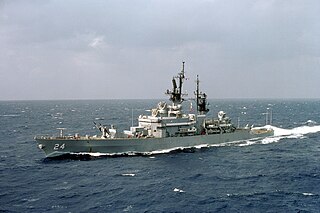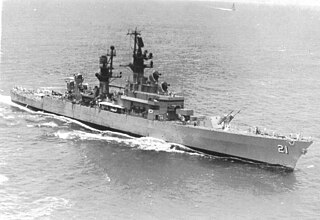
USS Boston (CA-69/CAG-1), a Baltimore-class heavy cruiser and later a Boston-class guided missile cruiser, was the sixth ship of the United States Navy to be named for the U.S. city of Boston, Massachusetts. Boston was launched 26 August 1942 by Bethlehem Steel Company's Fore River Shipyard in Quincy, Massachusetts, sponsored by Mrs Helen Noonan Tobin, wife of the Mayor of Boston, Maurice J. Tobin, and commissioned 30 June 1943.

USS Long Beach (CLGN-160/CGN-160/CGN-9) was a nuclear-powered guided missile cruiser in the United States Navy and the world's first nuclear-powered surface combatant. She was the third Navy ship named after the city of Long Beach, California.

USS Reeves (DLG/CG-24), a United States Navy ship named after Admiral Joseph Mason Reeves, was a Leahy-class cruiser built by the Puget Sound Naval Shipyard, in Bremerton, Washington.

USS Parsons (DD-949/DDG-33) began her career as a Forrest Sherman-class destroyer of the United States Navy. She was named in honor of Rear Admiral William S. Parsons (1901–1953), who worked on the Manhattan Project during World War II.

USS Dale (DLG-19/CG-19) was a Leahy-class cruiser in service with the United States Navy from 1963 to 1994. She was sunk as a target in 2000 off the East Coast of the United States near Maryland.

USS Canberra (CA-70/CAG-2) was a Baltimore-class cruiser and later a Boston-class guided missile cruiser of the United States Navy (USN). Originally to be named USS Pittsburgh, the ship was renamed before launch to honor the Australian cruiser HMAS Canberra sunk during the Battle of Savo Island. Canberra was the first USN warship named after a foreign capital city, and one of the few named after a foreign warship not captured in battle with a USN ship.

USS Gridley (DLG-21/CG-21), a Leahy-class guided missile cruiser, was the third ship of the United States Navy to be named after Charles Vernon Gridley, who distinguished himself with Admiral George Dewey's force at the Battle of Manila Bay on 1 May 1898.

The Convair RIM-2 Terrier was a two-stage medium-range naval surface-to-air missile (SAM), among the earliest SAMs to equip United States Navy ships. It underwent significant upgrades while in service, starting with beam-riding guidance with a 10-nautical-mile (19 km) range at a speed of Mach 1.8 and ending as a semi-active radar homing (SARH) system with a range of 40 nmi (74 km) at speeds as high as Mach 3. It was replaced in service by the RIM-67 Standard ER (SM-1ER).

USS Belknap (DLG-26/CG-26), named for Rear Admirals George E. Belknap (1832–1903) and his son Reginald Rowan Belknap (1871–1959), was the lead ship of her class of guided missile cruisers in the United States Navy. She was launched in 1963 as DLG-26, a guided missile frigate under the then-current designation system, and reclassified as CG-26 on 30 June 1975.

USS Chicago (CA-136/CG-11) was a Baltimore-class heavy cruiser laid down on 28 July 1943 at Philadelphia, Pennsylvania, US, by the Philadelphia Navy Yard. Launched on 20 August 1944, she was sponsored by Mrs. Edward J. Kelly, wife of the Mayor of Chicago, Illinois, and commissioned at the Philadelphia Navy Yard on 10 January 1945, Captain Richard R. Hartung, USN, in command. She served in some of the last battles around the Japan home islands in WWII, and as part of the post war occupation fleet. Decommissioned after the war, she was refitted as a missile cruiser beginning in the late 1950s and recommissioned in 1964, serving during the Vietnam War. She served until 1980. USS Chicago CG-11 carried the title of "The World's Most Powerful Guided Missile Cruiser".

USS Leahy (DLG/CG-16) was the lead ship of a new class of destroyer leaders in the United States Navy. Named for Fleet Admiral William D. Leahy, she was commissioned on 4 August 1962 as DLG-16, a guided missile frigate, and reclassified as CG-16, a guided missile cruiser, on 30 June 1975.

USS Harry E. Yarnell (DLG/CG-17) was a Leahy-class guided missile cruiser of the United States Navy. Named in honor of Admiral Harry E. Yarnell, she was originally classified as a "destroyer leader" or frigate, in 1975 she was redesignated a cruiser in the Navy's ship reclassification. She was the second of the "double-end" Leahy-class guided missile frigates to join the fleet.

Destroyer leader (DL) was the United States Navy designation for large destroyers from 9 February 1951 through the early years of the Cold War. United States ships with hull classification symbol DL were officially frigates from 1 January 1955 until 1975. The smaller destroyer leaders were reclassified as destroyers and the larger as cruisers by the United States Navy 1975 ship reclassification so destroyer escorts could be reclassified as frigates (FF) in conformance with international usage of the term.

USS Richmond K. Turner was a Leahy-class cruiser destroyer leader in the United States Navy. The ship was named for Admiral Richmond K. Turner, who served during World War II.

The Belknap-class cruiser was a class of single-ended guided-missile cruisers built for the United States Navy during the 1960s. They were originally designated as DLG frigates, but in the 1975 fleet realignment, they were reclassified as guided missile cruisers (CG).

Leahy-class cruisers were a class of guided-missile cruisers built for the United States Navy. They were originally designated as Destroyer Leaders (DLG), but in the 1975 cruiser realignment they were reclassified as guided-missile cruisers (CG).

USS Sterett (DLG/CG-31) was a Belknap-class destroyer leader / cruiser. She was the third ship to be named for Master Commandant Andrew Sterett (1778–1807), who served during the Quasi-War with France and the Barbary Wars. She was launched as DLG-31, a frigate, and reclassified a cruiser (CG) on 30 June 1975.

USS William H. Standley (DLG/CG-32) was a Belknap-class destroyer leader / cruiser. She was named for Admiral William Harrison Standley, former Chief of Naval Operations and ambassador to the Soviet Union. She was launched as DLG-32, a frigate, and reclassified Cruiser on 30 June 1975.

USS Mahan (DLG-11/DDG-42), was a Farragut-class guided missile destroyer in the United States Navy. She was named for Rear Admiral Alfred Thayer Mahan USN (1840–1914). The ship was laid down as DLG-11 by the San Francisco Naval Shipyard on 31 July 1957 and launched on 7 October 1959. Mahan was sponsored by Mrs. H. P. Smith, wife of Vice Adm. Harold Page Smith, and commissioned on 25 December 1960. Mahan was reclassified as a guided missile destroyer on 30 June 1975 and designated DDG-42. USS Mahan was decommissioned on 15 June 1993 and stricken from the Naval Vessel Register on the same day.

The USS Halsey was a Leahy-class guided missile cruiser of the United States Navy named in honor of Fleet Admiral William Halsey. Originally called a destroyer leader or frigate (DLG-23), on 30 June 1975 she was redesignated a cruiser (CG-23) in the U.S. Navy's ship reclassification.



















